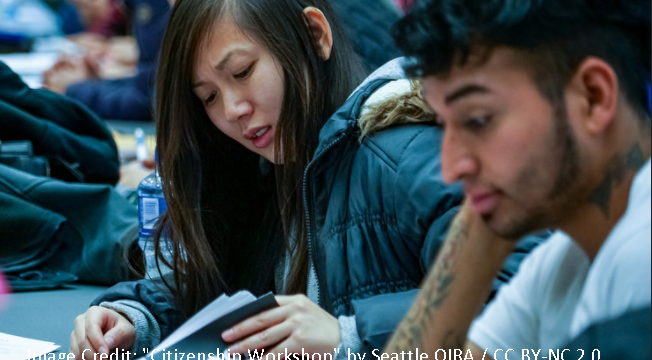Higher education’s social responsibility to refugees
Patrick Blessinger and Enakshi Sengupta
St. John’s University (NYC), USA and American University of Kurdistan
The number of displaced people around the world has reached unprecedented levels. The United Nations High Commissioner for Refugees, or UNHCR, estimates that more than 65 million people worldwide have been forcibly displaced from their homes due to extreme violence, war, persecution and similar factors.
Currently, people are being displaced at a rate of about 20 people per minute. Particularly disturbing is that most of the growth in displaced people has occurred over the past five years.
About one-third of the 65 million displaced people are classified as refugees. Over 50% of all refugees are children. The UNHCR defines a refugee as a person who is forced to leave her or his home country to escape extreme violence, war, persecution and man-made disasters and is granted asylum in another country.
Most displaced people come from a handful of countries such as Syria, Afghanistan, Somalia and Sudan, but irrespective of where they come from, the crisis is a global one, requiring a global effort.
As explained in the University World News article, “Inclusive higher education must cater for refugees”, universal education and lifelong learning are a basic human right for all people, including displaced people. Lack of access to education is especially problematic for refugees due to their lack of a homeland, their citizenship ambiguity, as well as language and other barriers.
In the book series, Refugee Education, we, along with several refugee scholars and educators, present current research in refugee education where we discuss how educational and other organisations are addressing this worldwide crisis.
As a response to the refugee crisis, the International Higher Education Teaching and Learning Association, in special consultative status with the United Nations Economic and Social Council, has launched an international research project to study the main issues involved in the refugee crisis.
Addressing the refugee crisis
The huge increase in the number of refugees in recent years is having a significant impact on the world. Asylum is the protection granted by a nation to asylum-seekers who seek sanctuary in a nation not their own due to their displaced status. When a request for asylum is granted, that person is then given refugee status.
Per the UNHCR Global Trends Report, of those displaced people who applied for asylum, most come from Syria, Afghanistan and Iraq. These three countries accounted for about 750,000 of the new asylum applications.
Most of the people seeking refuge in Turkey come from Syria. This helped make Turkey the fourth-largest recipient of new asylum applications. Countries which grant sanctuary provide physical and legal protection to refugees and also work towards providing permanent residence and naturalisation.
The number of people fleeing their home countries in recent years is perhaps only comparable to the number of people displaced by World War II. However, currently, only 37 countries participate in the resettlement of refugees.
Presumably, some nations, even prosperous nations, may be reluctant to take in refugees for fear of job loss, integration costs and other concerns. Nonetheless, in 2016, UN member states signed the New York Declaration for Refugees and Migrants which committed nations to enhancing the protection of refugees and migrants worldwide.
Applicants from the most devastated countries, like war-torn Syria, have the highest likelihood of getting their application for asylum approved. The largest number of new asylum applicants seek to enter Germany which received more than 700,000 applications in 2016 with one-third of them from Syria. Germany received as many asylum applications as the next 10 countries combined.
Germany is not only viewed as a welcoming, peaceful and prosperous country with stable political, economic and social systems, but it also has made the commitment to respond to the refugee crisis like no other country.
The United States received the second-largest number of asylum applications with half of them from Mexico and Central America. Italy had the third-largest number of applications with most of them from Nigeria, Pakistan, the Gambia and Senegal. Today, Germany, together with the US and Turkey, have the largest number of refugees living in their borders.
The one percent
Education, at all levels, as a human right is codified in many declarations and international laws, including the 1948 Universal Declaration of Human Rights, the 1951 Refugee Convention, the 1989 Convention on the Rights of the Child and the International Bill of Human Rights, among others. Unfortunately, however, access to education is not universally guaranteed in some countries, especially for displaced children.
Moreover, given the centrality of teaching and learning to all educational institutions at all levels, efforts to make learning available to all is also one of the top human rights issues today. As such, higher education institutions, as part of their social responsibility, should do more to address the growing refugee problem.
To that end, as colleges and universities become more aware of the plight of refugees, more programmes and scholarships are becoming available. This is important because lack of finances is one of the top challenges for refugees. This reality, coupled with the relatively high cost of tuition and living expenses at many colleges and universities, can turn the challenge into a barrier.
For example, the European Commission established a trust fund to support educational programmes for refugees. The Institute of International Education leads a group of 60 colleges and universities to help Syrian refugees through scholarships.
Other important sources of educational support programmes include UNHCR Education, the European Resettlement Network, the US Department of Education, Borderless Higher Education for Refugees and the Refugee Center, among others.
The fact that only 1% of all adult refugees attend university makes the issue even more urgent. Like all people, refugees have dreams for a better life, one without oppression and violence.
Because they face challenges and obstacles beyond the normal human experience, they are more likely to be determined and resilient. Given the scale of the problem, colleges and universities should demonstrate their commitment as good global citizens by helping more refugees access higher education.
Suggested Citation:
Blessinger, P. & Sengupta, E. (2017). Higher education’s social responsibility to refugees, Higher Education Tomorrow, Volume 4, Article 13, https://www.patrickblessinger.com/higher-educations-social-responsibility-to-refugees
Or
Blessinger, P. & Sengupta, E. (2017). Higher education’s social responsibility to refugees, University World News, http://www.universityworldnews.com/article.php?story=20171213080206555
Copyright © [2017] Patrick Blessinger and Enakshi Sengupta
Disclaimer
Opinions expressed in this article are those of the author, and as such do not necessarily represent the position(s) of other professionals or any institution.




